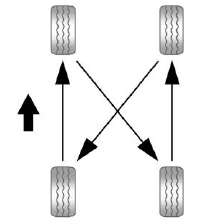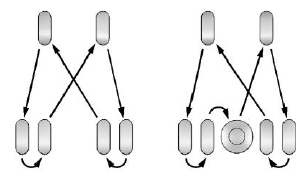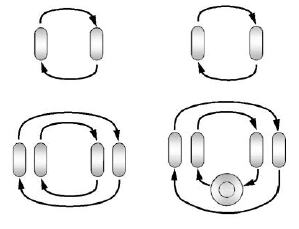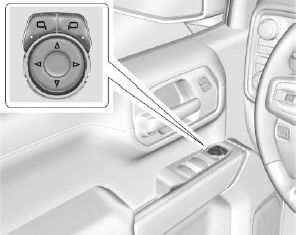Chevrolet Silverado: Wheels and Tires / Tire Rotation
Tires should be rotated every 12 000 km (7,500 mi). See Maintenance Schedule. Tires are rotated to achieve a more uniform wear for all tires. The first rotation is the most important.
Anytime unusual wear is noticed, rotate the tires as soon as possible, check for proper tire inflation pressure, and check for damaged tires or wheels. If the unusual wear continues after the rotation, check the wheel alignment. See When It Is Time for New Tires and Wheel Replacement.

Use this rotation pattern when rotating the tires if the vehicle has single rear wheels.
Dual Tire Rotation
When the vehicle is new, or whenever a wheel, wheel bolt, or wheel nut is replaced or serviced, check the wheel nut torque after 160, 1 600, and 10 000 km (100, 1,000, and 6,000 mi) of driving. For proper torque and wheel nut tightening information, see “Removing the Flat Tire and Installing the Spare Tire” under Tire Changing and “Wheel Nut Torque” under Capacities and Specifications and “Removing the Flat Tire and Installing the Spare Tire” under Tire Changing.
The outer tire on a dual wheel setup generally wears faster than the inner tire. Tires last longer and wear more evenly if they are rotated. See Tire Inspection and Tire Rotation. Also see Maintenance Schedule.
Warning
If the vehicle is operated with a tire that is underinflated, the tire can overheat. An overheated tire can lose air suddenly or catch fire. You or others could be injured. Properly inflate all tires, including the spare.
See Tire Pressure, for information on proper tire inflation.

Use this rotation pattern when rotating the tires if the vehicle has dual rear wheels (except polished forged aluminum wheels).
Vehicles with polished forged aluminum dual wheels have three unique wheels; a front, a rear outer and a rear inner. These wheels cannot be rotated to another position, however, they can be rotated from left to right to the same position.

Use this rotation pattern when rotating the tires if the vehicle has polished forged aluminum dual rear wheels. The spare wheel can be used in any position in the event of a flat tire, and can be rotated with the rear inner wheels. After the flat tire is repaired, if the spare is not on one of the inner rear positions, it must be replaced by the correct wheel in the front or rear outer positions.
When installing dual wheels, check that the vent holes in the inner and outer wheels on each side are lined up.
Adjust the front and rear tires to the recommended inflation pressure on the Tire and Loading Information label after the tires have been rotated. See Tire Pressure and Vehicle Load Limits.
Check that all wheel nuts are properly tightened. See “Wheel Nut Torque” under Capacities and Specifications, and “Removing the Flat Tire and Installing the Spare Tire” under Tire Changing.
Warning
Rust or dirt on a wheel, or on the parts to which it is fastened, can make wheel nuts become loose after time. The wheel could come off and cause a crash. When changing a wheel, remove any rust or dirt from places where the wheel attaches to the vehicle. In an emergency, a cloth or a paper towel can be used; however, use a scraper or wire brush later to remove all rust or dirt.
Lightly coat the inner diameter of the wheel hub opening with wheel bearing grease after a wheel change or tire rotation to prevent corrosion or rust build-up. Do not get grease on the flat wheel mounting surface or on the wheel nuts or bolts.
Reset the Tire Pressure Monitor System (TPMS), if the vehicle has one. See Tire Pressure Monitor Operation.
If the full-size tire is part of the tire rotation, make sure the tire rotated into the spare position is stored securely. Push, pull, and then try to rotate or turn the tire. If it moves, use the wheel wrench/hoist shaft to tighten the cable. See Tire Changing.
 Tire Inspection
Tire Inspection
We recommend that the tires, including the spare tire, if the vehicle has one,
be inspected for signs of wear or damage at least once a month.
Replace the tire if:
The indicators at three or more places around the tire can be seen...
 When It Is Time for New Tires
When It Is Time for New Tires
Factors, such as maintenance, temperatures, driving speeds, vehicle loading,
and road conditions affect the wear rate of the tires.
Treadwear indicators are one way to tell when it is time for new tires...
Other information:
Chevrolet Silverado 2019-2026 Owners Manual: Seat Belts
This section describes how to use seat belts properly, and some things not to do. Warning Do not let anyone ride where a seat belt cannot be worn properly. In a crash, if you or your passenger(s) are not wearing seat belts, injuries can be much worse than if you are wearing seat belts...
Chevrolet Silverado 2019-2026 Owners Manual: Engine Oil Pressure Gauge
Uplevel Metric Shown, Base Level and Midlevel Similar Uplevel English Shown, Base Level and Midlevel Similar The engine oil pressure gauge shows the engine oil pressure in kPa (kilopascals) or psi (pounds per square inch) when the engine is running...
Categories
- Manuals Home
- 4th Generation Silverado Owners Manual
- 4th Generation Silverado Service Manual
- Folding Mirrors
- Driver Information Center (DIC) (Midlevel and Uplevel)
- Heated Steering Wheel
- New on site
- Most important about car
Power Mirrors

To adjust each mirror:
Press  or
or
 to select the driver or passenger side
mirror. The indicator light will illuminate.
to select the driver or passenger side
mirror. The indicator light will illuminate.
